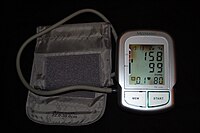
Photo from wikipedia
Objective: Objective. The new 2017 ACC/AHA Blood Pressure Guidelines changed the definition of hypertension and its treatment targets, reducing blood pressure (BP) thresholds from 140 and/or 90 mmHg to 130 and/or 80 mmHg.… Click to show full abstract
Objective: Objective. The new 2017 ACC/AHA Blood Pressure Guidelines changed the definition of hypertension and its treatment targets, reducing blood pressure (BP) thresholds from 140 and/or 90 mmHg to 130 and/or 80 mmHg. The aim of the study was to compare the percentage of hypertensives to target following the new threshold and the previous ones, by using OBP and AOBP measurements. Figure. No caption available. Design and method: Design and Method. 118 treated non-diabetic hypertensive adults afferent to our Hypertension Unit were included in the study. All underwent an AOBP measurement with Omron HEM-907XL following the SPRINT and Myers unattended methodology, followed by a traditional OBP measurement, obtained as the mean of three readings, with a Microlife BP A150 AFIB (Microlife, Swiss) with an appropriate cuff. All patients signed an informed consent and the study was approved by local ethical committee (CEI 652). Patients were classified according to BP measurement method and different guidelines (ESH/ESC 2013/AHA 2014 or AHA 2017). Pearson's correlation coefficient was used to evaluate agreement between AOBP and OBP measurement. Results: Results. Mean AOBP values were significantly lower than the “traditional” ones. A mean SBP and DBP difference respectively of 12.1 ± 15.9 mmHg and 3.6 ± 9.4 mmHg was found at Bland Altman analysis. Pearson's correlation coefficients were 0.65 for SBP and 0.67 for DBP. Receiver operating characteristic (ROC) curves and the area under curve (AUC) used for evaluating the diagnostic accuracy of the thresholds identified 130/79 mmHg as the best AOBP threshold in our population compared to OBP. 60% of patients were not to target with the ESH/ESC 2013/AHA 2014 vs 86% with AHA2017 by using OBP, while only 25% and 44% remained uncontrolled respectively with ESH/ESC 2013/AHA2014 and AHA2017 by using AOBP. Conclusions: Conclusions. Our data confirm that the new BP thresholds will dramatically increase the number of hypertensives not to target, but only when the “traditional” OBP measurement is used. In conclusion, these new guidelines will lead to important modifications in hypertension management, starting from BP measurement, even if a general adoption of AOBP may raise practical and economical concerns.
Journal Title: Journal of Hypertension
Year Published: 2018
Link to full text (if available)
Share on Social Media: Sign Up to like & get
recommendations!